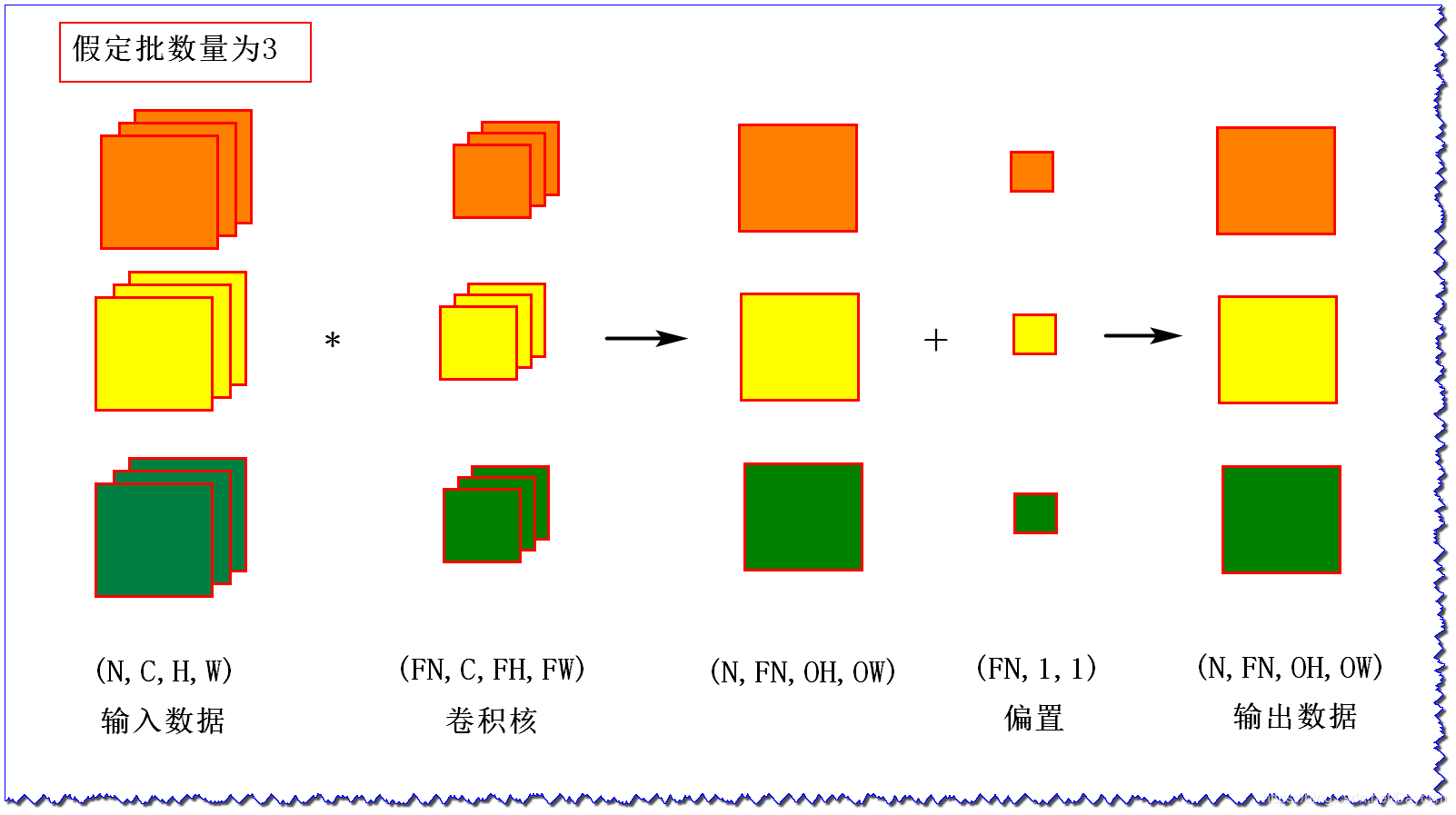版权声明:本文为博主原创文章,未经博主允许不得转载。 https://blog.csdn.net/Daycym/article/details/83826222
一、回顾
上一篇 我们介绍了,卷积神经网的卷积计算和池化计算,计算过程中窗口一直在移动,那么我们如何准确的取到窗口内的元素,并进行正确的计算呢?
另外,以上我们只考虑的单个输入数据,如果是批量数据呢?
首先,我们先来看看批量数据,是如何计算的
二、批处理
在神经网络的处理中,我们一般将输入数据进行打包批处理,通过批处理,能够实现处理的高效化和学习时对mini-batch的对应
自然,我们也希望在卷积神经网络的卷积运算中也使用批处理,为此,需要将在各层间传递的数据保存为四维数据

如上图
- 输入数据:批数目为3,通道为3
- 卷积核:数目为3,通道为3
- 输出数据:数目为3,通道为1
三、四维数据
如上所述,CNN中各层将传递的数据是四维数据,例如:
- 数据形状为(10,1,28,28),表示10个高为28,长为28,通道为1的数据

CNN中处理四维数据,按照以上的操作会很复杂,但是通过im2col这个技巧,就会变得很简单
四、im2col
- 对于输入数据

- 对于卷积核

输入数据展开以适合卷积核(权重)
- 输入数据,将应用卷积核的区域(3维数据)横向展开为一行
- 卷积核,纵向展开为1列
- 计算乘积即可
- 批量计算

五、python实现im2col和col2im
- np.pad()函数
import numpy as np
A = np.arange(1,5).reshape(2,2) # 将1,2,3,4转换为2*2的矩阵
print(A)
B = np.pad(A,((1,1),(2,2)),'constant')
# ((1,1),(2,2))
# 对A矩阵进行扩充,(1,1)表示上下各加一行,(2,2)左右各加两列
print(B)
输出为:
[[1 2]
[3 4]]
[[0 0 0 0 0 0]
[0 0 1 2 0 0]
[0 0 3 4 0 0]
[0 0 0 0 0 0]]
1、im2col
import numpy as np
def im2col(input_data, filter_h, filter_w, stride=1, pad=0):
"""
Parameters
----------
input_data : 由(数据量, 通道, 高, 长)的4维数组构成的输入数据
filter_h : 卷积核的高
filter_w : 卷积核的长
stride : 步幅
pad : 填充
Returns
-------
col : 2维数组
"""
# 输入数据的形状
# N:批数目,C:通道数,H:输入数据高,W:输入数据长
N, C, H, W = input_data.shape
out_h = (H + 2*pad - filter_h)//stride + 1 # 输出数据的高
out_w = (W + 2*pad - filter_w)//stride + 1 # 输出数据的长
# 填充 H,W
img = np.pad(input_data, [(0,0), (0,0), (pad, pad), (pad, pad)], 'constant')
# (N, C, filter_h, filter_w, out_h, out_w)的0矩阵
col = np.zeros((N, C, filter_h, filter_w, out_h, out_w))
for y in range(filter_h):
y_max = y + stride*out_h
for x in range(filter_w):
x_max = x + stride*out_w
col[:, :, y, x, :, :] = img[:, :, y:y_max:stride, x:x_max:stride]
# 按(0, 4, 5, 1, 2, 3)顺序,交换col的列,然后改变形状
col = col.transpose(0, 4, 5, 1, 2, 3).reshape(N*out_h*out_w, -1)
return col
# 测试
x = np.random.rand(3, 3, 4, 4) # 随机数生成
print(im2col(x,2,2,2,0))
print(im2col(x,2,2,2,0).shape)
输出为:
[[0.8126537 0.0124403 0.98329453 0.57534957 0.01075175 0.28476833 0.55240652 0.71247792 0.8866451 0.08312604 0.82491841 0.53558742]
[0.29177981 0.50891739 0.58534285 0.18979016 0.82281101 0.82324137 0.56737161 0.31075336 0.02638588 0.63497472 0.32696265 0.96400363]
[0.18770887 0.80279488 0.80743415 0.01885739 0.6043541 0.1325915 0.99802281 0.70238769 0.03320778 0.21225932 0.73413182 0.68671415]
[0.63299868 0.71823646 0.81703541 0.20652069 0.05803092 0.78660436 0.86116481 0.24152935 0.75596431 0.97947061 0.84386563 0.53657106]
[0.77410888 0.92973798 0.42845759 0.20494453 0.55320755 0.86069213 0.14749488 0.5110566 0.19249778 0.38564893 0.78868462 0.49548582]
[0.28778559 0.67286705 0.6351968 0.50743453 0.42905218 0.20382354 0.04566382 0.32610886 0.60199126 0.21139752 0.06912991 0.69890244]
[0.03473951 0.67443498 0.53320896 0.44542062 0.96787968 0.92660522 0.8726162 0.54056736 0.62510367 0.12935292 0.35858458 0.88899527]
[0.08295843 0.86116853 0.11507337 0.27507467 0.43662151 0.23341227 0.66133038 0.32065362 0.07386012 0.45717299 0.00857706 0.26429706]
[0.5203922 0.79072121 0.0861702 0.64400793 0.76287695 0.53397396 0.61997931 0.88647105 0.07416818 0.23701745 0.91067976 0.14036269]
[0.92652241 0.90052592 0.28945134 0.10758509 0.66142524 0.81998174 0.29023353 0.10070337 0.84680753 0.38787205 0.62224245 0.25184519]
[0.00896273 0.86085848 0.72448385 0.97710942 0.27221302 0.30631167 0.80608232 0.92652234 0.35904511 0.26833127 0.72821478 0.72382557]
[0.31399633 0.12624691 0.37392867 0.71121627 0.98641763 0.01551433 0.82284883 0.67615753 0.21826556 0.90338993 0.41159445 0.98961608]]
(12, 12)
我们设置如上图中的形状
- 输入数据:(3,3,4,4)
- 卷积核:(2,2)
- 结果为:(12,12)
结果和图中的结果一样,12行(3个数据,每个数据4行),每行有12个元素(应用(2,2)卷积核1次,三个通道,322=12)
2、col2im
def col2im(col, input_shape, filter_h, filter_w, stride=1, pad=0):
N, C, H, W = input_shape
out_h = (H + 2*pad - filter_h)//stride + 1
out_w = (W + 2*pad - filter_w)//stride + 1
col = col.reshape(N, out_h, out_w, C, filter_h, filter_w).transpose(0, 3, 4, 5, 1, 2)
img = np.zeros((N, C, H + 2*pad + stride - 1, W + 2*pad + stride - 1))
for y in range(filter_h):
y_max = y + stride*out_h
for x in range(filter_w):
x_max = x + stride*out_w
img[:, :, y:y_max:stride, x:x_max:stride] += col[:, :, y, x, :, :]
return img[:, :, pad:H + pad, pad:W + pad]
六、实现卷积层
class Convolution:
# 初始化权重(卷积核4维)、偏置、步幅、填充
def __init__(self, W, b, stride=1, pad=0):
self.W = W
self.b = b
self.stride = stride
self.pad = pad
# 中间数据(backward时使用)
self.x = None
self.col = None
self.col_W = None
# 权重和偏置参数的梯度
self.dW = None
self.db = None
def forward(self, x):
# 卷积核大小
FN, C, FH, FW = self.W.shape
# 数据数据大小
N, C, H, W = x.shape
# 计算输出数据大小
out_h = 1 + int((H + 2*self.pad - FH) / self.stride)
out_w = 1 + int((W + 2*self.pad - FW) / self.stride)
# 利用im2col转换为行
col = im2col(x, FH, FW, self.stride, self.pad)
# 卷积核转换为列,展开为2维数组
col_W = self.W.reshape(FN, -1).T
# 计算正向传播
out = np.dot(col, col_W) + self.b
out = out.reshape(N, out_h, out_w, -1).transpose(0, 3, 1, 2)
self.x = x
self.col = col
self.col_W = col_W
return out
def backward(self, dout):
# 卷积核大小
FN, C, FH, FW = self.W.shape
dout = dout.transpose(0,2,3,1).reshape(-1, FN)
self.db = np.sum(dout, axis=0)
self.dW = np.dot(self.col.T, dout)
self.dW = self.dW.transpose(1, 0).reshape(FN, C, FH, FW)
dcol = np.dot(dout, self.col_W.T)
# 逆转换
dx = col2im(dcol, self.x.shape, FH, FW, self.stride, self.pad)
return dx
七、实现池化层

class Pooling:
def __init__(self, pool_h, pool_w, stride=1, pad=0):
self.pool_h = pool_h
self.pool_w = pool_w
self.stride = stride
self.pad = pad
self.x = None
self.arg_max = None
def forward(self, x):
N, C, H, W = x.shape
out_h = int(1 + (H - self.pool_h) / self.stride)
out_w = int(1 + (W - self.pool_w) / self.stride)
# 展开
col = im2col(x, self.pool_h, self.pool_w, self.stride, self.pad)
col = col.reshape(-1, self.pool_h*self.pool_w)
# 最大值
arg_max = np.argmax(col, axis=1)
out = np.max(col, axis=1)
# 转换
out = out.reshape(N, out_h, out_w, C).transpose(0, 3, 1, 2)
self.x = x
self.arg_max = arg_max
return out
def backward(self, dout):
dout = dout.transpose(0, 2, 3, 1)
pool_size = self.pool_h * self.pool_w
dmax = np.zeros((dout.size, pool_size))
dmax[np.arange(self.arg_max.size), self.arg_max.flatten()] = dout.flatten()
dmax = dmax.reshape(dout.shape + (pool_size,))
dcol = dmax.reshape(dmax.shape[0] * dmax.shape[1] * dmax.shape[2], -1)
dx = col2im(dcol, self.x.shape, self.pool_h, self.pool_w, self.stride, self.pad)
return dx
总结
- 本篇的难点在于数据的展开和逆转换
- 关于卷积层和池化层的计算也比较好理解,但是代码实现有点绕,不过原理和神经网络中的全连接层实现方式一样